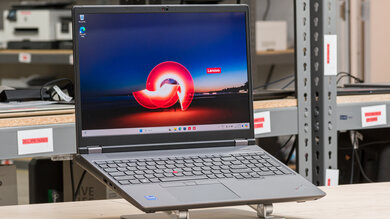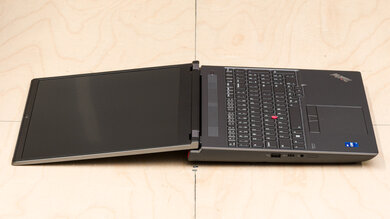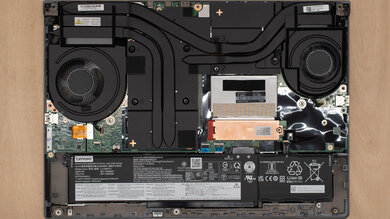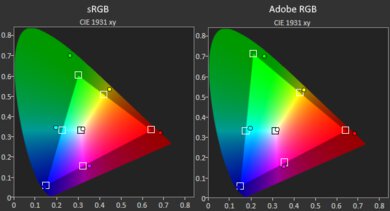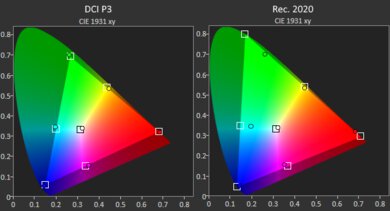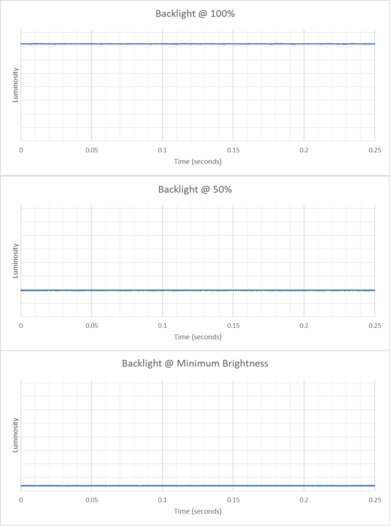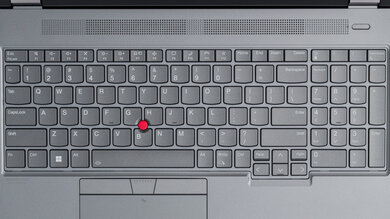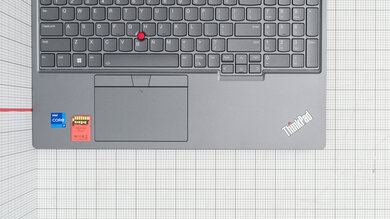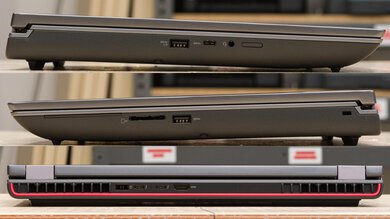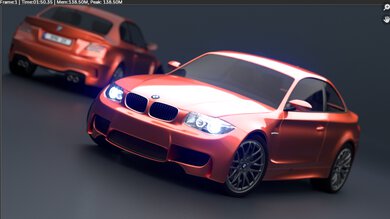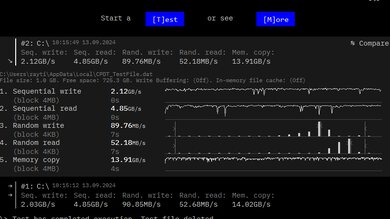The Lenovo ThinkPad P16 Gen 2 (2024) is a 16-inch mobile workstation. This '21FA/21FB' model replaces the Lenovo ThinkPad P16 Gen 1 from 2023 (Intel 12th Gen). It's available with Intel 13th and 14th Gen HX CPUs paired with integrated graphics, an Intel Arc A30M discrete GPU, or NVIDIA RTX discrete GPUs, up to an RTX 5000 Ada Generation Laptop GPU. Memory configuration maxes out at 128GB (ECC or non-ECC), though it's user-upgradeable to 192GB. You can get up to 4TB of storage; some options are available in a RAID 0/1 array. Ports include two USB-As, three USB-Cs (two Thunderbolt 4s), an HDMI 2.1, an SD Express 7.0 card reader, and a headphone jack. A Smart Card reader, NFC support, and cellular connectivity are available as optional features.
See our unit's specifications and the available configuration options in the Differences Between Variants section.
Our Verdict
The Lenovo ThinkPad P16 Gen 2 (2024) is good for school use. It provides a pretty good user experience overall with its large 16-inch display, comfortable keyboard, and small but responsive touchpad. Performance is outstanding; it's available with fast CPUs and discrete GPUs that can handle intensive workloads, making it suitable for students in fields like engineering and 3D modeling. Unfortunately, the fans get pretty loud, which isn't ideal for quiet settings like classrooms and libraries. Also, the laptop is bulky and heavy, making it hard to carry around, so it's best suited as a desktop replacement. Its battery life is decent, though, lasting around 10 hours of light use.
-
Multiple display options, including a 4k+ IPS panel with high brightness and an OLED panel.
-
Comfortable keyboard with numpad, small but responsive touchpad.
-
Battery lasts around 10 hours of light use.
-
Can handle demanding tasks.
-
Bulky and heavy.
-
Gets hot and loud under load.
-
Can't charge laptop via USB-C.
The Lenovo ThinkPad P16 Gen 2 (2024) is good for gaming. It's available with fast CPUs and GPUs that can deliver a relatively smooth gaming experience; however, the performance can still vary depending on the game, as the GPUs are designed for professional workloads, so they don't always have the best game drivers. They also lack gaming features like DLSS and Frame Generation. As for the display, although there's a 165Hz QHD+ panel option, it doesn't support VRR to reduce screen tearing. Unfortunately, the laptop gets hot and loud under load.
-
Can handle demanding tasks.
-
Wide port selection, including two Thunderbolt 4s.
-
165Hz display option.
-
User-replaceable RAM and storage.
-
No VRR support.
-
Gaming performance can vary due to driver optimization; no gaming features like DLSS.
-
Gets hot and loud under load.
The Lenovo P16 Gen 2 (2024) is good for media consumption. It has a large 16-inch display, and there are multiple panel options, including a sharp, colorful 4k+ OLED touchscreen. As for the speakers, although they get very loud with minimal compression, they're only good for spoken content, as they sound boxy with almost no bass. Battery life is pretty good at around six hours of video playback, but this laptop is bulky and heavy, so it isn't the best for on-the-go use.
-
Multiple display options, including a 4k+ IPS panel with high brightness and an OLED panel.
-
Battery lasts around six hours of video playback.
-
Loud speakers.
-
Bulky and heavy.
-
Speakers sound boxy with almost no bass.
-
Can't charge laptop via USB-C.
The Lenovo ThinkPad P16 Gen 2 (2024) is an outstanding workstation. It's available with high-performance CPUs and discrete GPUs that can handle even the most demanding workloads, like 3D modeling and simulations. There are multiple display options, including 4k+ panels that are suitable for color work. You can configure the laptop with up to 128GB of RAM and 4TB of storage, and these components are user-replaceable, so you can upgrade or add more later on. The CPU throttles a bit despite the laptop's robust cooling system, and unfortunately, the laptop gets hot and loud under load.
-
Can handle demanding tasks.
-
Wide port selection, including two Thunderbolt 4s.
-
4k+ display options with full DCI P3 coverage.
-
User-replaceable RAM and storage.
-
Gets hot and loud under load.
-
Some CPU throttling under load.
The Lenovo ThinkPad P16 Gen 2 (2024) is great for business use. It provides a good user experience overall, as it has a large display for multitasking, a comfortable, full-size keyboard with a numpad, and a small but responsive touchpad. There's a wide port selection, so you can easily plug in multiple peripherals and external displays. Performance is outstanding; all of the available CPUs and GPUs can easily handle productivity tasks like text processing, spreadsheets, and presentations. They can even handle demanding video editing if you need to make videos for your business. The main downside is that it's hard to carry around due to its bulky design.
-
Multiple display options, including a 4k+ IPS panel with high brightness and an OLED panel.
-
Comfortable keyboard with numpad, small but responsive touchpad.
-
Battery lasts around 10 hours of light use.
-
Optional cellular connectivity.
-
Bulky and heavy.
-
Gets hot and loud under load.
-
Can't charge laptop via USB-C.
- 7.6 School
- 7.6 Gaming
- 7.5 Multimedia
- 9.0 Workstation
- 8.2 Business
- Updated Sep 24, 2024: Review published.
- Updated Sep 18, 2024: Early access published.
- Updated Sep 04, 2024: Our testers have started testing this product.
- Updated Aug 29, 2024: The product has arrived in our lab, and our testers will start evaluating it soon.
- Updated Aug 19, 2024: We've purchased the product and are waiting for it to arrive in our lab.
Differences Between Sizes And Variants
We tested the Lenovo ThinkPad P16 Gen 2 (model 21FA0050US) with a 4k+ IPS display, an Intel Core i7-14700HX CPU, an NVIDIA RTX 1000 Ada Generation Laptop GPU, 32GB of RAM, and 1TB of storage. The display, CPU, GPU, memory, and storage are configurable; the options are in the table below. This review applies to all variants with a model number starting with '21FA' and '21FB'.
| Screen |
|
|---|---|
| CPU |
|
| GPU |
|
| Memory |
|
| Storage |
|
| Color |
|
See our unit's label.
Compared To Other Laptops
The Lenovo P16 Gen 2 is an outstanding mobile workstation. It has a wide range of configuration options, with the top-end models providing enough processing power for the most demanding tasks. However, its bulky and heavy design makes it better suited as a desktop replacement rather than a laptop for on-the-go use. Also, the quality of certain parts, like the speakers, touchpad, and webcam, aren't nearly as good as other laptops in its class.
For more options, see our recommendations for the best workstation laptops, the best laptops for video editing, and the best laptops for graphic design.
The Lenovo ThinkPad P16 Gen 2 (2024) and the Apple MacBook Pro 16 (M3, 2023) are both outstanding 16-inch workstation laptops. In terms of the overall build and user experience, the MacBook Pro comes out ahead, as it has a sturdy all-aluminum chassis, a larger and more responsive haptic touchpad, better-sounding speakers, and a higher-quality webcam. It also has longer battery life and doesn't get as hot or loud under load. Both laptops can handle demanding workloads; however, the Lenovo is a better option if you're looking for raw GPU performance, as its higher-end GPU configurations, like the NVIDIA RTX 4000 and 5000 Ada Generation Laptop GPUs are much faster than the M3 Max SoC's GPU. The Lenovo has a few advantages over the MacBook Pro: its memory and storage drive are user-replaceable, and it's available with cellular connectivity.
The Lenovo ThinkPad P16 Gen 2 (2024) and the Lenovo ThinkPad P1 Gen 7 (2024) are both 16-inch mobile workstations; however, they're quite different, as the P16 is a much bulkier model intended as a desktop replacement, whereas the P1 Gen 7 is much more compact and better suited for on-the-go use. The latter's sleeker and more compact design comes at the cost of performance, though, as its Intel Meteor Lake CPUs aren't nearly as fast as the P16's Intel 14th Gen HX processors, and its GPU configuration maxes out at an RTX 3000 running at 60W, while the P16 Gen 2 is available with up to an RTX 5000 running at 115W. The user experience is better on the P1 Gen 7; it has a larger and more responsive haptic touchpad, a higher-quality webcam, and longer battery life. On the other hand, the P16 has more optional features, like cellular connectivity, NFC support, and a Smart Card reader.
The Lenovo ThinkPad P16 Gen 2 (2024) and the HP ZBook Power G11 A (2024) are both mobile workstations designed for professional workloads like CAD and simulations. They provide a relatively similar user experience overall; the Lenovo has sharper display options and a more comfortable keyboard, but the HP has a better webcam and a significantly longer battery life. The main difference is that the Lenovo is an Intel system, while the HP is an AMD system. You'll get more performance out of the Lenovo if you go with the higher-end configurations, especially when it comes to the GPU, as the Lenovo is available with faster NVIDIA RTX 4000 and 5000 Ada Generation Laptop GPUs. The Lenovo is also available with up to 128GB of ECC or non-ECC RAM (user-upgradeable to 192GB), making it better suited for memory-intensive tasks, whereas the HP is only available with up to 64GB.
The Lenovo ThinkPad P16 Gen 2 (2024) and the Dell XPS 16 (2024) are both high-end laptops designed to handle demanding tasks. However, the Lenovo is better suited for professional workloads like 3D modeling and simulations because it's available with NVIDIA RTX Ada Generation Laptop GPUs, whereas the Dell is better suited for content creation because it's available with the more mainstream NVIDIA GeForce GPUs. As for the CPU, you'll get more performance out of the Lenovo's Intel Raptor Lake CPUs, but the Dell's Meteor Lake CPUs have a Neural Processing Unit to speed up A.I. tasks and low-power E-cores to help prolong battery life. Each laptop has its pros and cons when it comes to the user experience; the Dell has a more premium, sleeker design, but the Lenovo has a wider port selection, and its keyboard and touchpad are easier to get used to. The Lenovo also has more optional features, like cellular connectivity and NFC support.
Test Results
The Lenovo ThinkPad P16 Gen 2 is only available in the Storm Gray colorway. See the bottom of the laptop.
The Lenovo P16 Gen 2's build quality is excellent. The construction is a mix of aluminum and plastic, with no signs of obvious gaps. It feels very sturdy, exhibiting little to no flex on the lid or keyboard deck, and the display doesn't twist when manipulating it, either. The finish doesn't scratch easily, but it does pick up a fair amount of fingerprints and smudges, especially on the touchpad and the bottom. The feet feel solid and stick firmly to the bottom.
The hinge is outstanding. It feels smooth when opening and closing the lid, and it's very stable, exhibiting almost no wobble when typing heavily or manipulating the display. Its wide range lets you push the screen past 180 degrees, which is handy when you need to share content with someone sitting opposite you.
The Lenovo ThinkPad P16's serviceability is excellent. Accessing the internals is easy; you need to remove 12 Philips screws and release the clips holding the bottom panel with a prying tool. The screws are captive, meaning they remain attached to the panel, which makes the reassembly easier. Two of the RAM slots are on the other side of the motherboard (below the keyboard). They aren't hard to access, but you have to be careful, as there are wires that can break. Both storage slots support M.2 2280 PCIe Gen 4 SSDs. There's also an empty slot for a WWAN adapter if you want cellular connectivity.
See the hardware maintenance manual.
The Lenovo P16 Gen 2 is available with the following displays:
- FHD+ 60Hz (IPS, matte, 100% sRGB, 300 cd/m²)
- FHD+ 60Hz (IPS, matte, 100% sRGB, 400 cd/m²)
- QHD+ 165Hz (IPS, matte, 100% sRGB, 500 cd/m²)
- 4k+ 60Hz (IPS, matte, 100% P3, 800 cd/m²)
- 4k+ 60Hz (OLED, touchscreen, glossy, 100% P3, 400 cd/m²)
The choice of the display depends on your preference and needs. Naturally, the 4k+ (3840 x 2400) displays are the sharpest, with a pixel density exceeding that of the Apple MacBook Pro's Mini LED display. The QHD+ (2560 x 1600) panel has a pixel density of 188 PPI, while the FHD+ (1920 x 1200) panels have a density of 141 PPI. The FHD+ screens are fine sharpness-wise; you can likely see individual pixels up close or have very good vision, but it isn't an issue at typical viewing distances and won't significantly impact the user experience if you aren't doing any type of content creation work. All of the available panels have a 16:10 aspect ratio. This format is great for productivity, as you get more vertical space than a standard 16:9 display, allowing you to see more information when reading a document or website. Lastly, keep in mind that the OLED panel is susceptible to permanent burn-in, especially with static content like Windows' taskbar.
The Lenovo ThinkPad P16 Gen 2's 4k+ IPS panel has a basic 60Hz refresh rate with a slow response time, resulting in a blurry image with visible ghosting in fast-moving scenes. The 60Hz FHD+ IPS panels are likely similar in performance. If you care about input responsiveness and motion smoothness, it's best to go with the QHD+ panel, as it has a 165Hz refresh rate. The 4k+ OLED panel has a 60Hz refresh rate but likely a much faster response time, as most OLEDs do. None of the displays support VRR to reduce screen tearing when gaming.
The 4k+ panel's contrast ratio is quite good for an IPS display. That said, this contrast level still makes blacks look gray in dim settings. The other IPS panels are likely in the same 1000:1 to 2000:1 range. The 4k+ OLED panel has a near-infinite contrast ratio since OLEDs can turn off individual pixels to produce perfect blacks.
The 4k+ IPS display gets very bright. It doesn't quite reach the advertised 800 cd/m², but it's still plenty bright for most indoor settings and even outdoors in broad daylight. The FHD+ IPS and 4k+ OLED panels are mostly for indoor use, with advertised brightness of 300 to 400 cd/m². The QHD+ IPS panel has an advertised brightness of 500 cd/m², which is good enough for outdoor use, but you may still have trouble seeing some content, especially if there's sunlight shining directly on the screen.
The display's reflection handling is excellent. For the most part, you'll only have trouble with reflections when viewing dark-color content. The other IPS panels have the same matte coating. The 4k+ OLED display has a glossy finish and will likely struggle more with direct, mirror-like reflections.
The 4k+ IPS display’s horizontal viewing angle is okay. The image dims and washes out fairly quickly when moving to the side, so you need to be close or directly in front of the screen to get perfect accuracy. The other IPS displays are likely similar. As for the 4k+ OLED display, it’s probably better in regards to color washout and brightness loss but will suffer more from color shift.
The vertical viewing angle is mediocre. Again, the image looks dimmer and more washed out from above or below. You need to look at the screen more or less straight on to see an accurate image.
The display's accuracy is sub-par when there isn't a color profile selected. The white balance is visibly off at higher brightness levels with too much red, and the colors are also inaccurate because the default color space is in DCI P3, causing oversaturation. There's a slight reddish tint caused by the warm color temperature, and the gamma doesn't follow the curve at all, over-brightening most scenes.
Here are additional measurements in the Default, sRGB, DCI P3, and Adobe RGB color profiles:
Default
sRGB
DCI P3
Adobe RGB
The Lenovo P16 Gen 2's 4k+ IPS display has an outstanding color gamut. It has full coverage of the commonly used sRGB color space and of the wider DCI P3 color space, making it suitable for media consumption and HDR video production. Its Adobe RGB coverage is excellent, though it's missing a bit of the highly saturated greens that define Adobe RGB. The FHD+ and QHD+ displays only have full coverage of the sRGB color space, while the 4k+ OLED display has full DCI P3.
The Lenovo P16 Gen 2 has an excellent keyboard. Its layout feels spacious and is relatively standard; the only thing that might take some time to get used to is the position of the left CTRL key, which is next to the Windows key, with the FN key on the outside. The keys have a good amount of travel, require little force to actuate, and provide clear tactile feedback. They aren't the most stable keys, but the wiggling isn't bad enough to impact the typing experience significantly. The backlight is adjustable but could be a little brighter.
The Lenovo P16 Gen 2 has a good touchpad. Though small for a 16-inch laptop, it tracks all movements and gestures well, even around the edges. Palm rejection work as intended, and there are no issues performing actions like dragging and dropping or zooming in and out of images. Since this is a diving board touchpad, you can technically only click in the bottom half, but you can always use the dedicated buttons at the top. The buttons provide good tactile feedback and are relatively quiet.
As for the Trackpoint nub between the letters G, H, and B, it's essentially a secondary way of controlling the cursor. It's convenient because you don't have to move your hand as much to move the cursor, but it may take some time to get used to because it's pressure-sensitive.
The speakers get pretty loud with minimal compression at high volume levels. They're mostly for spoken content—they sound clear but boxy, with very little voice and instrument separation and almost no bass.
The Lenovo P16 Gen 2's webcam video quality is decent. Although the resolution is 1080p, the image looks a bit soft, with some fine details appearing blurry. There's noise in certain areas, and the exposure is too low, making colors look unnatural. Voices sound relatively clear over the microphone, with very little background noise.
The privacy cover is only a physical barrier, so it doesn't disable the camera or microphone at the software level. You can disable the microphone using the F4 shortcut.
The Lenovo P16 Gen 2's port selection is outstanding. Both USB-As support USB 3.2 Gen 1 data transfer speed of up to 5Gbps. The one on the left is always on, meaning you can use it to charge a mobile device even when the laptop is in sleep mode. The two USB-Cs on the back of the device support Thunderbolt 4 (up to 40Gbps data transfer speed and two 4k displays @ 60Hz) and DisplayPort, while the USB-C on the left side only data transfer (up to 10Gbps). All three USB-Cs support Power Delivery 3.0, but only for charging external devices, meaning you can't use them to charge the laptop. Models with an NVIDIA discrete GPU have a true HDMI 2.1 port capable of outputting up to an 8k @ 60Hz signal, while models with Intel UHD or Arc graphics can only output up to 4k @ 60Hz. You can get the laptop with an optional Smart Card reader and/or a Nano-SIM card slot (cellular connectivity).
The Lenovo P16 Gen 2's wireless adapter is an Intel Wi-Fi 6E AX211. Wi-Fi 6E gives access to the 6GHz band, providing faster speeds, lower latency, and less signal interference than previous Wi-Fi standards. However, you need a router that supports Wi-Fi 6E to benefit from these features. You can get the laptop with cellular connectivity; the WWAN adapter is a Fibocom L860-GL-16 with embedded eSIM functionality.
The Lenovo ThinkPad P16 Gen 2 is available with the following CPUs:
- Intel Core i5-13600HX (14 cores/20 threads, up to 4.8GHz, 24MB cache)
- Intel Core i7-13700HX (16 cores/24 threads, up to 5.0GHz, 30MB cache)
- Intel Core i7-13850HX (20 cores/28 threads, up to 5.3GHz, 30MB cache)
- Intel Core i9-13950HX (24 cores/32 threads, up to 5.5GHz, 36MB cache)
- Intel Core i9-13980HX (24 cores/32 threads, up to 5.6GHz, 36MB cache)
- Intel Core i7-14700HX (20 cores/28 threads, up to 5.5GHz, 33MB cache)
The available CPUs are all high-performance processors typically found in gaming and workstation laptops. They can handle general productivity tasks, as well as highly demanding workloads like CAD and scientific simulations. These Raptor Lake CPUs—and the 14th Gen Raptor Lake refresh—have a hybrid architecture with performance and efficiency cores, but unlike the Meteor Lake CPUs found in laptops such as the Dell XPS 16 (2024), they don't have any low-power E-cores to further improve battery life or an NPU (Neural Processing Unit) to speed up A.I. tasks. The choice of the CPU depends on the complexity of your workload and the speed at which you expect to complete tasks. Naturally, more cores will result in better multi-thread performance. There isn't much difference between Intel's 13th and 14th Gen CPUs; the Core i7-14700HX is simply a refresh of the Core i7-13700HX with faster clock speeds and a slightly larger cache, giving it marginally better performance.
For more information, see Intel's product briefs for its 13th Gen HX and 14th Gen HX CPUs.
The Lenovo ThinkPad P16 Gen 2 is available with the following GPUs:
- Intel UHD Graphics (integrated)
- Intel Arc Pro A30M Graphics 4GB GDDR6 (discrete, 35W TGP)
- NVIDIA RTX A1000 Laptop GPU 6GB GDDR6 (discrete, 60W TGP)
- NVIDIA RTX 1000 Ada Generation Laptop GPU 6GB GDDR6 (discrete, 60W TGP)
- NVIDIA RTX 2000 Ada Generation Laptop GPU 8GB GDDR6 (discrete, 60W TGP)
- NVIDIA RTX 3500 Ada Generation Laptop GPU 12GB GDDR6 (discrete, 115W TGP)
- NVIDIA RTX 4000 Ada Generation Laptop GPU 12GB GDDR6 (discrete, 115W TGP)
- NVIDIA RTX 5000 Ada Generation Laptop GPU 16GB GDDR6 (discrete, 115W TGP)
The list above shows the available GPUs in order of their raw performance. All models come with integrated graphics to handle light, general productivity tasks like text processing and web browsing. The weakest discrete GPU on the list is the Intel A30M, which has roughly the processing power of an NVIDIA GeForce GTX 1650, an entry-level GPU based on NVIDIA's older Turing architecture. Next on the list is the RTX A1000, which is akin to an NVIDIA GeForce RTX 3050, sporting 2,048 CUDA cores. The rest are from NVIDIA's newest generation of GPUs based on the Ada Lovelace architecture, similar to the GeForce RTX 40-series cards. The RTX 1000 is akin to an RTX 4050, while the highest-end RTX 5000 is akin to an RTX 4090. Like the CPU, the choice of the GPU depends on your workload, its complexity, and the speed at which you expect to complete tasks. You can play games on models with an RTX Ada Generation GPU; just know that the performance won't be as good as on models with a GeForce GPU, as they don't always get the best drivers. They also lack features like DLSS and Frame Generation.
See more information about the Arc A30M on Intel's website. You can see the NVIDIA GPUs' full specifications on NVIDIA's website.
You can configure the Lenovo ThinkPad P16 Gen 2 with 8GB, 16GB, 32GB, 64GB, or 128GB of RAM. Some configurations are in single-channel mode, which will limit the system's performance, so it's best to get a dual-channel configuration if you don't plan on upgrading yourself. Depending on the configuration, you can also choose between ECC (Error Correction Code) or non-ECC RAM. Lenovo specifies that even though the laptop comes with 5600MHz modules, the laptop can only run the memory at 3600MHz or 4000MHz due to platform limitations. If you plan on upgrading the memory yourself, know that you can insert up to 128GB of RAM when using ECC modules and up to 192GB (4x 48GB) when using non-ECC modules. See the specifications on Lenovo's website.
You can configure the Lenovo ThinkPad P16 Gen 2 with 256GB, 512, 1TB, 2TB, or 4TB of storage. You can get models with two SSDs in a RAID 0 or 1 array; RAID 0 will give you the best speeds, but know that the failure of one drive can cause data loss on both drives. Lenovo labels some SSDs as ‘Performance’ drives, but it’s unclear what that means, as there’s no mention of the exact SSD model or the expected speeds. The storage is user-replaceable; both slots support M.2 2280 PCIe Gen 4 NVMe SSDs.
The Lenovo ThinkPad P16 Gen 2 with an Intel Core i7-14700HX scores remarkably well in the Geekbench 5 benchmarks. Every configuration can handle a variety of productivity workloads, including demanding tasks like programming and simulations. That said, there are faster CPUs on the market. Compared to an Apple MacBook Pro 16 (M3, 2023) with a 16-core M3 Max SoC, the Intel Core i7-14700HX is roughly 19% slower in single-thread and 36% slower in multi-thread performance. As for the GPU, the NVIDIA RTX 1000 Ada Generation Laptop GPU also performs well, scoring in the same ballpark as an RTX 4050. All of the available discrete GPUs can handle demanding tasks, so choose based on your needs and budget.
Below are benchmark scores from Geekbench 6 in case you're more familiar with those numbers:
- CPU Single-Thread: 2,837
- CPU Multi-Thread: 15,941
- GPU Compute: 82,408
The Lenovo P16's Intel Core i7-14700HX scores exceptionally well in the Cinebench R23 benchmarks. This level of performance is suitable for highly demanding, sustained workloads. All of the available CPUs can handle intensive tasks; generally speaking, more cores will give you better multi-thread performance.
Below are benchmark scores from Cinebench 2024 in case you're more familiar with those numbers:
- Single-Thread: 122
- Multi-Thread: 1,267
The Lenovo ThinkPad P16 Gen 2 is outstanding for Blender work. A model with an NVIDIA discrete GPU is preferable, as even the lowest-end RTX A1000 can render images faster than the CPU and iGPU. Intel's Arc GPU can get the job done, too, but it isn't nearly as fast as the NVIDIA discrete GPUs.
The Basemark GPU score is outstanding and in the expected range for an NVIDIA RTX 1000 Ada Generation Laptop GPU. All models with a discrete GPU can handle gaming; you just have to tweak the settings a bit, depending on the GPU model. That said, performance can still vary from one game to another because, as mentioned in the GPU section, these professional GPUs don't always get the best game drivers. They also lack performance-boosting features like DLSS and Frame Generation. Intel's UHD iGPU is designed for light productivity only, so don't expect to play anything more intensive than light puzzle-like games or older and highly optimized titles. As for Intel's Arc GPU, it's a relatively low-end discrete graphics processor with performance in the same ballpark as an NVIDIA GeForce GTX 1650, so it can only handle some demanding titles at 720p or 1080p with low settings.
The Lenovo ThinkPad P16 G2's battery life varies depending on the configuration. A lower resolution display and/or lower-end GPU (integrated UHD Graphics and Arc GPU) will result in a longer battery life, while a higher-end, more power-hungry GPU (NVIDIA RTX 3500, 4000, and 5000 Ada Generation Laptop GPU) will result in a shorter battery life.
Borderlands 3 runs decently well at 1080p on the Lenovo P16. You can get over 60 fps with an Intel Core i7-14700HX and an NVIDIA RTX 1000 Ada Generation Laptop GPU configuration, but the gameplay isn't always smooth due to frame drops. Configurations with a more powerful GPU will deliver higher frame rates, but you'll likely still experience occasional stutters. As for models with an Intel Arc A30M or RTX A1000 GPU, you'll likely have to play at a lower resolution and with low graphical settings to get playable frame rates in this and other similarly demanding games.
Every configuration of the Lenovo ThinkPad P16 G2 can handle Civilization VI and other similar strategy games with few issues. Models with integrated graphics only will struggle a bit, but you can still get playable frame rates with the lowest graphical settings.
Every configuration of the Lenovo P16 with a discrete GPU can run Counter-Strike 2 and other similar games with few issues, though you'll have to tweak the settings a bit on models with an Intel Arc A30M.
Shadow of the Tomb Raider runs well. Every configuration can deliver smooth gameplay in this and other similarly demanding games except for models with integrated graphics. Intel's Arc A30M can likely push over 60 fps; you just have to tweak the settings a bit. The large frametime spikes are scene changes and aren't representative of the performance.
The keyboard deck gets a little toasty under load and can cause some discomfort, as the hot spot is near the center of the keyboard. Unfortunately, the bottom of the laptop gets even hotter, reaching 53.1 °C (127.58 °F). The laptop's feet prevent the bottom from making direct contact with your legs, but still, you might want to get a lap desk if you absolutely need to use the device on your lap.
The Lenovo P16 Gen 2 has many pre-installed applications, including:
- Dolby Access: Adds Dolby Atmos support and allows you to change the speakers' sound profile.
- Glance by Mirametrix: A software application that adds attention-sensing capability. When enabled, it can automatically lock your computer when you walk away, pause a video, blur the content when you aren't directly looking at the screen, or move windows from one screen to another.
- Intel Graphics Command Center: Lets you adjust the display's contrast, color, saturation, power management, and video enhancement settings.
- Lenovo Commercial Vantage: Lets you view system status, change various settings, and give access to IT admins to troubleshoot and fix issues.
- Lenovo View: Camera settings to improve video call quality.
- Solitaire & Casual Games: Solitaire, FreeCell, Spider, Mahjong, Sudoku, and other casual games.
- Synaptics Fingerprint Reader Preboot Manager: Lets you access settings for the fingerprint sensor.
- Thunderbolt Control Center: Lets you manage and approve the connection of devices connected via the Thunderbolt ports.
- X-Rite Color Assistant: Lets you calibrate the display and change the color space profile.
You can get the Lenovo ThinkPad P16 with Windows 11 Home or Pro, Fedora Linux, Ubuntu Linux LTS, Ubuntu Linux with Data Science Preload, or Red Hat Enterprise Linux 9.3. You can also get it with no pre-installed operating system if you want to install a custom OS.
The Lenovo ThinkPad P16 has a fingerprint sensor (integrated into the power button) and an optional Windows Hello facial recognition IR camera. You can use either to log in quickly, authorize purchases in the Windows Store, and auto-fill saved passwords on supported websites. NFC support is also available as an optional feature.


